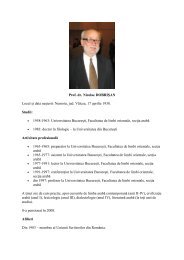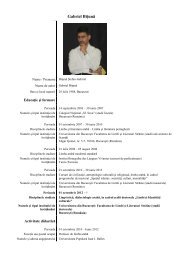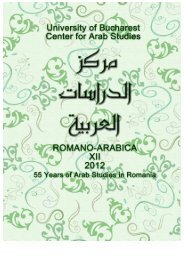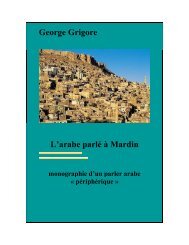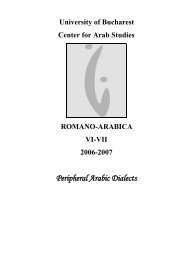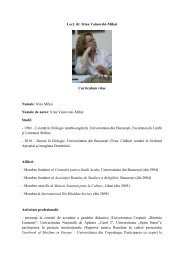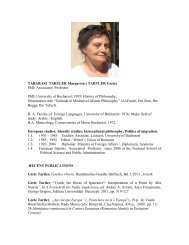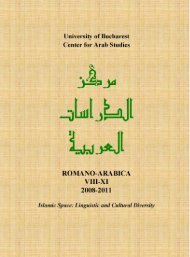Arabic Linguistics
Arabic Linguistics
Arabic Linguistics
You also want an ePaper? Increase the reach of your titles
YUMPU automatically turns print PDFs into web optimized ePapers that Google loves.
issue under discussion. Their acceptance or refusal of constructions based on this<br />
approach is very well established although we should be reminded continuously<br />
of the fact that, irrespective of how convincing these analogies are, the ultimate<br />
aim of the grammarians is to prove the inner logic of the language and the<br />
interrelatedness of its components. The chapter on kāna and its sisters is<br />
particularly rich in this respect. Indeed, the very fact that these so-called<br />
―incomplete‖ verbs (af„āl nāqis}a) exercise rection is attributed to their analogy to<br />
―real‖ or complete verbs (af„āl h}aqīqiyya). 24 More specifically, since transitive<br />
verbs exercise a twofold rection by causing the nominative in the subject (fā„il)<br />
and the accusative in the direct object (maf „ūl bihi), kāna and its sisters were seen<br />
to be given analogically a twofold rection as well and were made to cause the<br />
nominative in the subject (ism) and the accusative in the predicate (hàbar).<br />
Moreover, the permissibility of sentence 2, where the predicate of kāna is placed<br />
before its noun, and sentence 3, where the predicate is placed before kāna and its<br />
noun, is ascribed to analogy since it is permissible to place the direct object before<br />
the subject (e.g., d}araba „Amran Zaydun) or before the verb and the subject (e.g.,<br />
„Amran d}araba Zaydun). 25 Conversely, the impermissibility of placing the subject<br />
(fā„il) before the verb – as this would cause a sentence like qāma Zaydun to<br />
become Zaydun qāma, which is interpreted as a nominal sentence with Zaydun as<br />
its mubtada‟ – is said to be carried over to kāna through analogy. 26<br />
Other instances of analogy between ―incomplete‖ and ―real‖ verbs include<br />
more complex constructions. Sentence 3a, for example, is accepted on the basis of<br />
its resemblance to another sentence in which a ―real‖ verb occurs in the same<br />
syntactic position as the ―incomplete‖ verb (cp. mā qā‟iman kāna Zaydun and the<br />
prophetic tradition mā l-faqra ah`šā „alaykum, where both qā‟iman and al-faqra<br />
precede the operant 27 ). Similarly, sentences of the type kāna t}a„āmaka Zaydun<br />
ākilan (no.27), such as kānat Zaydan al-h}ummā ta‟hùdu are rejected by some<br />
grammarians on the grounds that no operant (i.e., including ―real‖ verbs) may be<br />
separated from what it operates on by an alien element (ağnabī; t}ufaylī ), as in<br />
d}arabtu wa-dahaba „Amran Zaydun. 28<br />
The extent to which the grammarians availed themselves of qiyās in their<br />
discussion of word order in kāna constructions, however, can only be appreciated<br />
fully by examining how they analogically extended to kāna and its sisters the<br />
status of other particles or verbs. Without going into too many details, we shall<br />
restrict our examples to those in which qiyās was the arbiter in allowing or<br />
rejecting the patterns represented by constructions cited above:<br />
1. The Kufans and al-Ah`faš al-Awsat} are reported to have allowed sentence<br />
10 (qā‟iman mā zāla Zaydun) based on the analogy between mā zāla and another<br />
negative particle, lam, since qā‟iman lam yazal Zaydun is permissible. 29<br />
47



